



Hubble 25 Anniversary The Post-Industrial Civilization « The Urgeist Movement A recent study by the German Wuppertal Insittut for Climate, Environment and Energy estimates that for every 100% of primary energy (oil, coal, gas) utilized in the production of goods, only about one third comes out as a usable product. The rest is expelled as pollution. Transitioning to sustainability requires a radical decoupling of economic activity from the environment. The environmental problems we face are essentially economic problems. Products will have to be treated from cradle to cradle, instead of cradle to grave; and each phase of this cycle will need scrutiny and improvement in efficiency until we run a zero emissions economy. The German Government, for instance, initiated Gebaudersanierungsprogramm (building-renewal program) that has managed to draw 15% of its home heating energy from renewable sources. Another interesting gain in product efficiency takes place when consumers rent instead of own products. Oil is the life blood of industrial society. Like this:
History Home Kepler Mission To Find Earth-like Planets By Studying Planetary Transits Earlier this week we spoke about finding Earth-like planets, and how hard it is to find them. We would like to see other planets similar to Earth, and we have a few absolutely necessary conditions: the planet must be rocky, solid, dense like Earth, a source of power like a Sun, chemicals resulted from volcanic activity, and liquid water. The most important thing however, is that the planet must be located in the Goldilocks zone, the area where the planet is not too far and not too close from a star. In order to find such planets NASA has begun the Kepler Mission which will last four year. In the search of alien life scientists will have to be pay a lot of attention to the planetary transits because the changes of the brightness are very, very small. If you thought that it’s easy then please note that the Suns might change their brightness due to natural variation, and if a transit doesn’t repeat itself more than once in a year then chances are that’s not an exoplanet. via Physorg
Patterns In The Void › Anarchism, Particle Physics, Occultism, & Hacking So, while I’m busy researching away, hard at work reverse engineering proprietary network monitoring software , and trying to devise methodologies for detecting all the various and newly-emerging means for technological censorship that the world’s government seem to be oh - so - peachy - keen on developing (the State Department recently mentioned our research in their daily briefing), my friend Nadim gets to sit around, playing with crypto, doing things like implementing the Anubis cipher for Javascript and inventing secure music sharing services with 80s-retro aethetics . And then, he invents Cryptocat . Some of you might have heard of it. It’s OTR , in your browser, as client-side Javascript, and we’re hoping to build it into the Tor Browser Bundle someday. But…that OTR business…I don’t know. It’s so . Then! #! # kaepora # Sends an email to @kaepora about implementing MPOTR. # Requires 'dict' and 'fortune-mod', mutt as your configured # mail client, and some sort of MTA. TO="nadim@nadim.cc
Best UFO Info and Research Resources About: This is a reference Website. It offers a collection of hand-picked UFO resources: real UFO pictures (see the "summary" and "technical overview" pages), video documentaries, video footage and testimonies, technical data and over 500 links to scientific studies, books, portals, newsfeeds, blogs and forums about UFOs. In short, by combining info from many diverse sources, our goal is to share a selection of valuable, representative (in a some cases unique UFO info and original research), as concisely as possible and offer some possible answers. Also provide a "starting point" for in-depth info and gems of real value in a labyrinth of (often false) information published on the fascinating subject of UFOs. Use the links in the header and footer of each page to navigate around this site. Credible information on the UFO subject is notoriously difficult to find. You also can't rely on your trusted Internet search engine (Google, Yahoo etc).
NASAs 'Curiosity' Search for Life Targets Water-Altered Rock This rock's composition is unlike any other Opportunity has investigated during nine years on Mars -- higher in aluminum and silica, lower in calcium and iron. "Based on our current solar-array dust models, we intend to reach an area of 15 degrees northerly tilt before Opportunity's sixth Martian winter," said JPL's Scott Lever, mission manager. "Solander Point gives us that tilt and may allow us to move around quite a bit for winter science observations." Northerly tilt increases output from the rover's solar panels during southern-hemisphere winter. The first drive away from Esperance covered 81.7 feet (24.9 meters) on May 14. "There appears to have been extensive, but weak, alteration of Whitewater Lake, but intense alteration of Esperance along fractures that provided conduits for fluid flow," Squyres said. NASA's Mars Exploration Rover Project launched Opportunity to Mars on July 7, 2003, about a month after its twin rover, Spirit. The Daily Galaxy via NASA/JPL
Birds Before The Storm | anarchism, travel, music, and book design 国家航天局 · English 首 页 机构介绍 动态信息 政策公告 国际合作 航天工程 访谈直播 热点问题 航天知识 图 库 航天人物 机构职能 国际合作协调委员会 直属单位